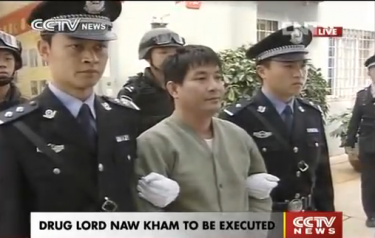
Burmese drug lord Naw Kham and fellow gang members Hsang Kham from Thailand, Yi Lai, and Zha Xika from Laos were executed by China on March 1, 2013 after being found guilty of killing 13 Chinese sailors on the Mekong River in 2011.
The execution grabbed the world’s attention for two reasons. First, Chinese state-run TV networks aired the execution parade, a decision which enraged many people in Myanmar and even in China. Second, the Chinese government admitted that it considered the use of drones in 2012 to capture Naw Kham who was then hiding in a rural village in Laos. It was the first time that China publicly acknowledged that it had acquired drones.
Naw Kham’s execution triggered widespread discussion about his criminal activities. Known as the ‘Godfather of the Golden Triangle’, Naw Kham led the 100-strong Hawngleuk Militia in the Shan State border town of Tachilek in Myanmar which engaged in drug trafficking, kidnapping and hijacking. With Myanmar as its heartland, the notorious Golden Triangle in mainland Southeast Asia is the world’s second largest producer of opium after Afghanistan.
Naw Kham’s gang also extorted protection money from cargo ships along the Mekong River. He became the most wanted man in China after his group killed 13 Chinese sailors who refused to pay in 2011. The ‘Mekong Tragedy’ prompted China, Laos, Myanmar and Thailand to launch joint patrols along the river and coordinate attempts to capture Naw Kham. His arrest drew comparisons to the successful operation by US forces to kill al-Qaeda leader Osama bin Laden.
How did Naw Kham elude arrest for so many years? It seems he was protected by high-ranking Burmese officials and apparently even by some villagers, says Myanmar’s Mizzima News:
He managed for nearly a decade to avoid efforts by the region’s law enforcement agencies to capture him because of the “protection and blessings” of both villagers and Burma’s military in the Tachilek and Kentung area of Shan State, officials said. He was looked upon as a “Robin Hood”, for the doling out of money he extorted from Mekong shipping.
Naw Kham’s tragic life also reminds us about the complexity of narco-politics in Myanmar. Shan Herald explains the link between the war on drugs and the raging civil war in north Myanmar:
No one is innocent in the war on drugs in Burma:
The people because of their desperate need for survival
The rebels to buy arms for the struggle against a tyrannical government
The government and its armed forces for encouraging allies to be involved in the drug trade to fight against the resistance and for allowing their units to be involved so they could feed, clothe and equip themselves
The circle becomes complete when greedy financiers take advantage of the state of affairs to invest, produce and trade in drugs
Khuensai Jaiyen of the Shan Drug Watch believes that a “political solution with armed ethnic groups” is the key to addressing the drug menace:
It’s time to end the vicious cycle of new drug lords emerging and being scapegoated over and again. The political root causes of the drug problem must be tackled
News about China’s possession of drones prompted a discussion about whether the Chinese government will authorize their use to protect state investments in Myanmar, in particular its gas pipeline project. Mizzima weighs on this matter:
Perhaps, but perhaps not. However the fact that China is making its southwestern neighbor aware of its military capabilities sends a message [that is] hard to ignore.
It is highly likely that Chinese patience and its committed policy of respecting sovereignty will be put to the test in the coming months—not only in containing the Kachin conflict, but also in protecting a vital pipeline from sabotage.
With regard to the live showing of the execution march, most Burmese and Chinese internet users have criticized the “unnecessary spectacle”. Nicholas Bequelin of Human Rights Watch described it as an ‘affront to human dignity’:
There is no reason to turn an execution into this grotesque show and it actually detracts from the effective dispensation of justice … no matter what they have done, they are not animals in a zoo.
For additional reading on this topic please see:
Unmanned Aerial Vehicles (Drones): An Introduction
The Global Regime for Transnational Crime
For more information on issues and events that shape our world please visit the ISN’s featured editorial content and Security Watch.

